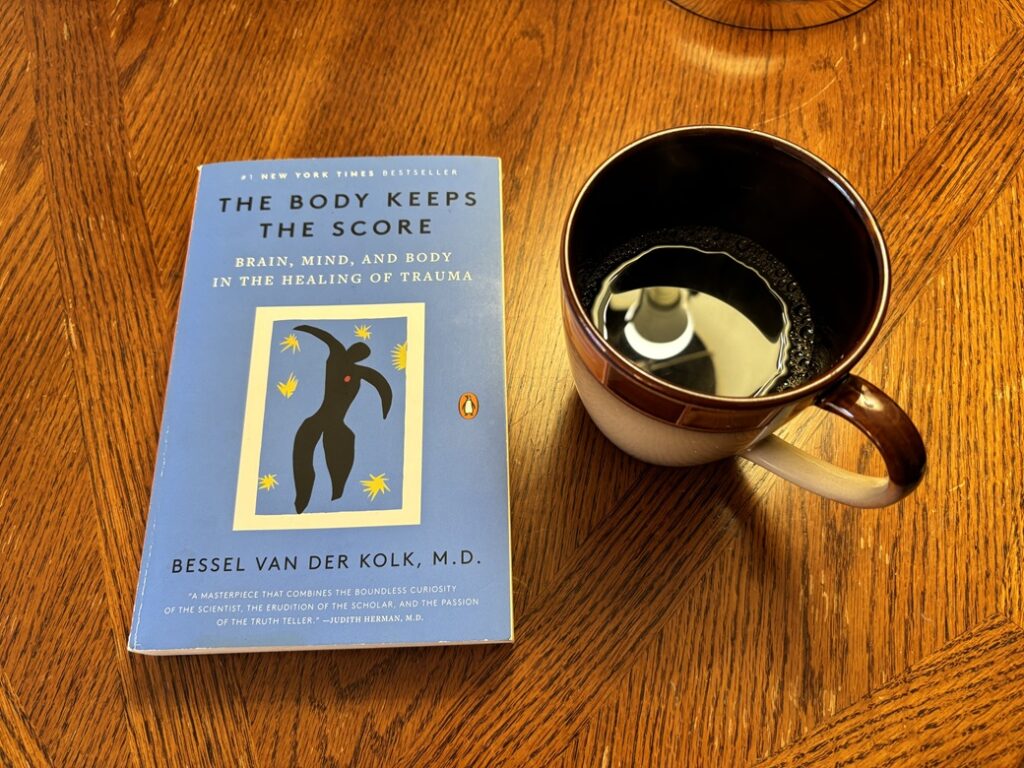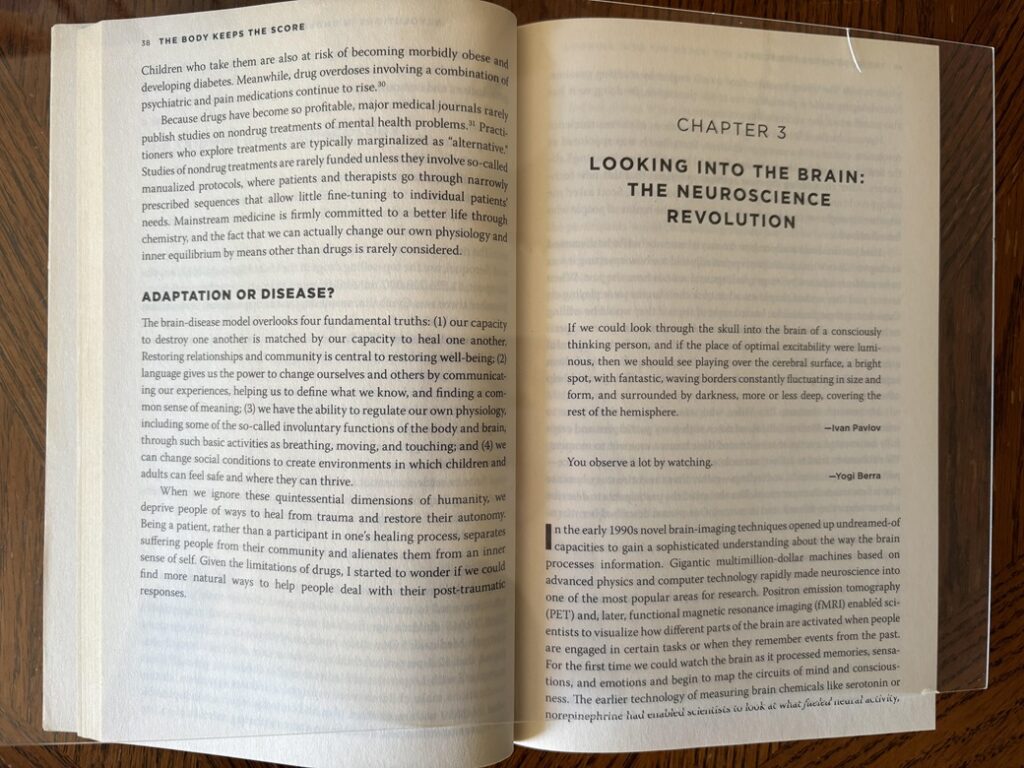1. INTRODUCTION: Childhood Trauma Causes Addiction
2. 12 Steps & 12 Traditions: Damaging Emotional Conflicts
3. Trauma Damages Left Brain Speech
4. BIOFEEDBACK: Meditation on Steroids
5. INTEROCEPTION: Traumatic Awareness
6. What Were You Thinking Right Before You Acted Out Your Childhood Trauma?
7. Communication is the Opposite of Trauma
8. ALEXITHYMIA: Inability to Feel Emotion
9. EMDR Reprocesses Body Awareness and Does Not Visit the Original Trauma in Detail
10. EMDR is for Patients So Traumatized That Full Recovery is Thought to Be Impossible.
11. Lock Down Your Childhood Trauma Instead of Acting it Out
12. Final Healing: The Patient’s Internal Landscape Manifests Critical Mass of Self
13. Eye Movement Desensitizing Reprocessing of Traumatic Memories

1. INTRODUCTION: Childhood Trauma Causes Addiction
Childhood trauma has the ability to superimpose itself upon everything around it in this present moment, this present mind.
This is parts one and two of my fourteen part synopsis and commentary of The Body Keeps the Score by Bessel van der Kolk.
Anesthetics like alcohol are a good way to temporarily dull the pain of childhood trauma. Traumatized people have a tendency to superimpose their trauma on everything around them and have trouble deciphering whatever is going on around them. There appears to be nothing in between. Van der Kolk also found that trauma affects the imagination. My theory is that this is why great artists are often traumatized individuals who both create great works of art as trauma self-therapy and/or resort to drugs and alcohol to numb their posttraumatic stress disorder.
Alcoholics like to imagine trauma
Even in my personal fantasies’ I am traumatized. Should alcoholics be fantasizing about creating imaginary trauma as is done in some 12 Step meetings? Me thinks not. Imagination is absolutely critical to the quality of our lives. Our imagination enables us to leave our routine everyday existence by fantasizing about travel, food, sex, falling in love or having the last word-all the things that make life interesting. Imagination gives us the opportunity to envision new possibilities-it is an essential launchpad for making our hopes and dreams come true. My over-reactions to the world are sometimes a result of post-traumatic distress disorder caused by my adverse childhood experiences.
2. Twelve Steps & Twelve Traditions: Damaging Emotional Conflicts Cause Alcoholism
“Very deep, sometimes quite forgotten, damaging emotional conflicts persist below the level of consciousness. At the time of these occurrences, they may actually have given our emotions violent twists which have since discolored our personalities and altered our lives for the worse.” -12 Steps & 12 Traditions, Step 8, pp. 79-80
“Our main problem is not how we are to stay married; it is how to be more happily married by eliminating the severe emotional twists that have so often stemmed from alcoholism.” -12 Steps & 12 Traditions, Step 12, p. 112
If these severe emotional twists occurred before our drinking began, if we were traumatized so long ago that the emotional twists are “sometimes quite forgotten”, then then according to the A.A. literature, our “damaging emotional conflicts” and “severe emotional twists” contributed to our developing the disease of alcoholism.
THE BODY KEEPS THE SCORE PART ONE: Posttraumatic Stress Disorder (PTSD)
In 1980, psychoanalysts treating war veterans successfully lobbied the American Psychiatric Association to create a new diagnosis: posttraumatic stress disorder (PTSD). However war is not the only calamity that leaves human lives in ruins. In many ways victims of sexual abuse and incest were suffering from symptoms no different than solders who were psychologically damaged from the trauma of war. The majority of Americans experience a violent crime at some time during their lives. -The Body Keeps the Score
Violence and Damaging Emotional Conflicts Caused My Alcoholism
Thirty years ago when I was a litigation paralegal at a major insurance company, one of my co-workers remarked behind my back that I was a ticking time bomb just waiting to go off. She was correct. I was a forty year-old man acting out my childhood trauma. My whole life I knew something was seriously wrong with me. After fifteen years of recovery the anesthesia finally started to wear off. I became truly sober. I actually experienced a power greater than myself restoring me to sanity. It was only after practicing the spiritual principles of love and forgiveness that a sixty year-old memory suddenly resurfaced with clarity:
Childhood Trauma
Once when I asked my parents about my getting hit in the head with a rock as a child, my Mexican mother told me that I was too young to remember. But I did remember. My body kept the score. My mother was a master of denial and she passed her gift of denial on to her traumatized children.
Permanent Piñata Party
When I was four years old at a piñata party in East Los Angeles, the violence of children whacking a hanging doll full of candy did not appeal to me. So as I went exploring this strange new barrio, some older Mexican kids threw a fist sized rock at my head when I wasn’t looking. I was the new kid in town and they decided to teach me a lesson that would haunt me for a lifetime. I received the first sucker punch of my life and it almost killed me. I woke up in the emergency room of Children’s Hospital in downtown Los Angeles with a concussion. My negligent parents took me back to the very same house where the violence happened, my great-grandmothers residence, and laid me down on great-grandma’s bed. Now I was surrounded by Catholic icons and statuettes. I vividly remember the Black Madonna and how it both frightened and intrigued me.
For the next sixty years I was re-experiencing this entire incident from beginning to the end over and over again. I internalized the violence as my mind detached further and further from my feelings and my body kept the score. I spent a thousand hours of my thought life reliving an incident that took a few seconds. I kept getting hit in the head by that rock over and over and over again.
My overwhelming traumatic childhood experiences affected my innermost sensations and my relationship to my physical reality–the core of who I am. This is particularly tragic, since it is very difficult for growing children to recover when the source of terror and pain is not the shell shock of war but the criminal negligence of their own caretakers. My PTSD made me into one of the most broken souls ever to recover his lost soul. -The Body Keeps the Score
Eye Movement Desensitizing Reprogramming (EMDR)
EMDR by a trained therapist incorporates the same rapid eye movements that the body produces while dreaming. Much like dreaming allows the subconscious mind to organize and heal from the events of our daily lives, EMDR allows the trauma stored in the body to be healed and purged. Only after I underwent EMDR therapy as a sixty year-old man did I begin to get completely well.
Now when I am at 12 Step Meetings I can discern the childhood trauma of my fellow alcoholics in their complicated speech and logic. We now know that more than half the people who seek psychiatric care have been assaulted, abandoned, neglected or even raped as children, or have witnessed violence in their families. One of the things that I find surprising in AA meetings is how little attention recovering alcoholics pay to who they love; what motivates and engages them, what made them feel at peace. This lack of peace seems to be one of the causes of alcoholism that I can see. That is why when I am sharing at AA meetings I say: my peace I give unto you. I would love to help other recovering alcoholics discover their own PTSD and causes of their alcoholism.
The greatest sources of our suffering are the lies we tell ourselves
Most human suffering is related to love and loss and the job of therapists is to help people “acknowledge, experience, and bear” the realities of life–with all its pleasures and heartbreak. The greatest sources of our suffering are the lies we tell ourselves. People can never get better without knowing what they know and feeling what they feel. Healing depends on experiential knowledge: You can be fully in charge of your life only if you can acknowledge the reality of your body, in all its visceral dimensions. Scared animals always return home, regardless of whether home is safe or frightening. Van der Kolk thought about his patients with abusive families who kept going back to be hurt again. Are traumatized people condemned to seek refuge in what is familiar? If so, why, and is it possible to help them become attached to places and activities that are safe and pleasurable? –The Body Keeps the Score
Addicted to Trauma: The Pain of Pleasure and the Pleasure of Pain
According to van der Kolk, many traumatized people seem to seek out experiences that would repel most of us, and patients often complain about a vague sense of emptiness and boredom when they are not angry, under duress, or involved in some type of dangerous activity. I see this in myself. My addiction to danger is one of the causes of my alcoholism.
Most sharing of pain in A.A. meetings is harmful to me now because it stops short of the complete and utter transformation that I seek
Freud had a term for such traumatic reenactments such as me yelling at strangers. Freud called it “the compulsion to repeat.” He and many of his followers believed that reenactments were an unconscious attempt to get control over a painful situation and that they eventually could lead to mastery and resolution. There is no evidence for that theory–repetition leads only to further pain and self-hatred. In fact, even reliving the trauma repeatedly in therapy may reinforce preoccupation and fixation. Traumatic reenactments seem to produce endorphins and that is why I seek out traumatic situations. That strong emotions can block pain was the result of morphinelike substances manufactured in the brain. This suggests that for many traumatized people, reexposure to stress might provide a similar relief from anxiety. Thus when recovering alcoholics are discussing their stress, it is probably temporarily relieving their anxiety. Wouldn’t it be more therapeutic to get down discussing the root trauma that they experienced as a child?
I SOMETIMES TALK ABOUT CHILDHOOD TRAUMA AS A TOPIC IN 12 STEP MEETINGS
According to The Body Keeps the Score: The brain-disease model overlooks four fundamental truths: (1) our capacity to destroy one another is matched by our capacity to heal one another. Restoring relationships and community is central to restoring well-being; (2) language gives us the power to change ourselves and others by communicating our experiences, helping us to define what we know, and finding a common sense of meaning; (3) we have the ability to regulate our own physiology, including some of the so-called involuntary functions of the body and brain, through such basic activities as breathing, yoga, moving and touching; and (4) we can change social conditions to create environments in which children and adults can feel safe and where they can thrive. We can eliminate childhood trauma.



